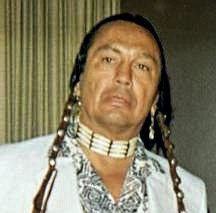
This date in 1939 marks the birth of Russell Charles Means, Oglala Lakota activist for the rights of Native American people, political activist, and film and television actor. He became a prominent member of the American Indian Movement (AIM) after joining the organization in 1968, and helped organize notable events that attracted national and international media coverage.
Means was active in international issues of indigenous peoples, including working with groups in Central and South America, and with the United Nations for recognition of their rights. He was active in politics at his native Pine Ridge Indian Reservation and at the state and national level.
Beginning an acting career in 1992, he appeared in numerous films, and released his own music CDs. He published his autobiography Where White Men Fear to Tread in 1995.
Means was born on the Pine Ridge Indian Reservation, South Dakota, and was given the name Wanbli Ohitika by his mother, which means “Brave Eagle” in the Lakota language.In 1942, the Means family resettled in the San Francisco Bay Area, seeking to escape the poverty and problems of the reservation. His father worked at a shipyard. Means grew up there, graduating in 1958 from San Leandro High School. He attended college, but did not graduate. His autobiographyrecounts a harsh childhood with an alcoholic father. Means himself fell into years of “truancy, crime and drugs” before finding purpose in the American Indian Movement in Minneapolis. By the end of his 20s he had lived in several Indian reservations throughout the U.S.
In 1968, Means joined the American Indian Movement (AIM), rising to become a prominent leader. In 1970, he was appointed AIM’s first national director, and the organization began a period of increasing protests and activism.
Means participated in the 1969 Alcatraz occupation, and on Thanksgiving Day 1970, he and other AIM activists staged their first protest in Boston: They seized the Mayflower II, a replica ship of the Mayflower, to protest the Puritans’ and later U.S. mistreatment of Native Americans. In 1971 Means was one of the leaders of AIM’s takeover of Mount Rushmore, a federal monumentwithin the Black Hills, an area sacred to the Lakota.In November 1972, he participated in AIM’s occupation of the Bureau of Indian Affairs headquarters in Washington, D.C., to protest abuses. Many records were taken or destroyed, and more than $2 million in damages was done to the building.
In 1973, Dennis Banks and Carter Camp led AIM’s occupation of Wounded Knee, which became the group’s best-known action.Means appeared as a spokesman and prominent leader. The armed standoff of more than 300 Lakota and AIM activists with the FBI and state law enforcement lasted for 71 days.
Means turned to the United Nations to establish the offices of the International Indian Treaty Council in 1977. At Pine Ridge he helped organize community institutions such as a radio station and health clinic.
In the 1980s, AIM divided into competing factions. Differences emerged regarding support for the indigenous peoples in Nicaragua. Means announced his support for the Miskito group MISURASATA, which was allied with the Contras. He traveled to the Atlantic Coast of Nicaragua in 1985 and 1986 on fact-finding tours, and believed that the Miskito as a people were being targeted for elimination. Other members of AIM supported the Sandinistas of the national government, although they had forced removal of thousands of Miskito from their traditional territory. At that time, the “Grand Governing Council” of AIM, based in Minnesota, asked Means to cease representing himself as a leader of the movement, while other chapters of AIM continued to support Means.
Means often supported libertarian political causes, and ran for vice president alongside Larry Flynt. In 1987, Means ran for the presidential nomination under the Libertarian Party, losing to Congressman Ron Paul. In 2004 and 2008, Means supported independent Ralph Nader.In January 2012, he announced his endorsement of Ron Paul in his bid for President.
In 2007, Means and 80 other protesters were arrested in Denver during a Columbus Day parade, which they stated was a “celebration of genocide.”
A notable film career
Beginning in 1992, Means appeared as an actor in numerous films and television movies, first in The Last of the Mohicans. He appeared as Arrowhead in the TV movie The Pathfinder,in Natural Born Killers, as Jim Thorpe in Windrunner: A Spirited Journey, as Sitting Bull inBuffalo Girls, and had a cameo in the miniseries Into the West.
He was a voice actor in Disney’s third highest-selling feature film Pocahontas and its sequel Pocahontas II: Journey to a New World, playing the title character’s father, Chief Powhatan. Means was a guest actor in the 1997 Duckman episode “Role With It,” in which Duckman takes his family on an educational trip to a “genuine Indian reservation” – which turns out to be a casino.Means appeared as Billy Twofeathers in Thomas & the Magic Railroad. He starred in Pathfinder, a 2007 movie about Vikings battling Native Americans in the New World, and co-starred in Rez Bomb, the first feature filmed on his native Pine Ridge Indian Reservation.
His musical CDs have been recognized by the Native American Music Awards with a Hall of Fame award. In addition, his paintings have been shown at various galleries around the world.Andy Warhol painted 18 individual portraits of Russell Means in his 1976 American Indian Series.Means is the focus of the 2014 documentary Conspiracy To Be Free by director Colter Johnson.
Means died on October 22, 2012, shortly before his 73rd birthday. His ashes were sprinkled throughout the Black Hills.
Adapted from Wikipedia.
Photo: Wikipedia (CC)










